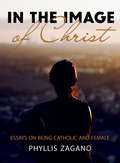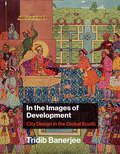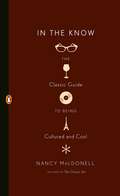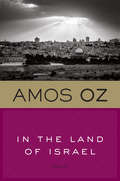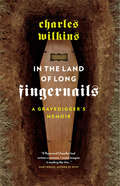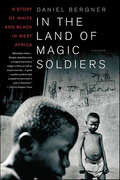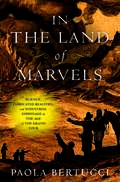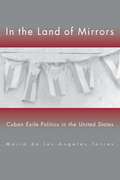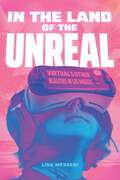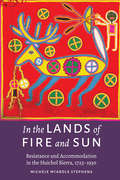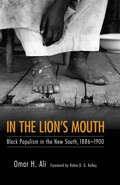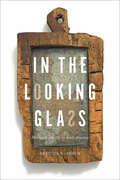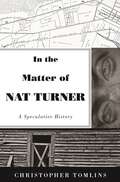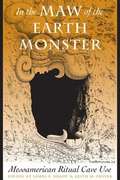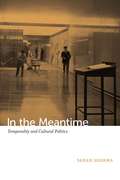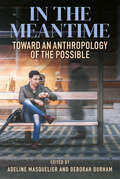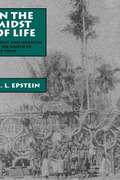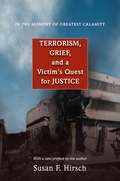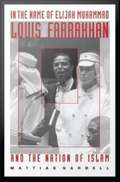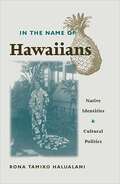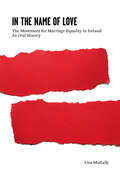- Table View
- List View
In the Image of Christ: Essays on Being Catholic and Female
by Phyllis ZaganoHere is the book that tells what it is like to be female and Catholic in the twenty-first century. In this collection of twenty-three short essays, Phyllis Zagano, a well-respected author and speaker on women in society and in the Church, gives a no-holds-barred description of the experience of Catholic women that will be both illuminating and challenging to women, men, and the hierarchy alike. In the process she tells stories that are poignant, humorous, infuriating, and sometimes sad.
In the Images of Development: City Design in the Global South (Urban and Industrial Environments)
by Tridib BanerjeeThe urban legacy of the Global South since the colonial era and how sustainable development and environmental and social justice can be achieved. Remarkably little of the expansive literature on development and globalization considers actual urban form and the physical design of cities as outcomes of these phenomena. The development that has shaped historic transformations in urban form and urbanism—and the consequent human experiences—remains largely unexplored. In this book, Tridib Banerjee fills this void by linking the idea of development with those of urbanism, urban form, and urban design, focusing primarily on the contemporary cities in the developing world—the Global South—and their intrinsic prospects in city design. Further, he examines the endogenous possibilities for the future design of these cities that may address growing inequality and the environmental crisis. Banerjee deftly traces the urban legacy of the Global South from the beginning of the colonial era, closely examining the economic, political, and ideological forces that influenced colonial and postcolonial development, drawing from relevant experiences of different cities in the developing world and discussing the arguments for the historic parity of these cities with their Western counterparts. Finally, Banerjee considers essential notions of future city design that are grounded in the critical challenges of sustainable development, equity, environmental and social justice, and diversity, and how such outcomes can be achieved. This book serves as the opening of a long overdue conversation among design, development, and planning scholars and practitioners, and those interested in the urban development of the Global South.
In the Know
by Nancy MacdonellThere are still a few things money can't buy. Love is one, cool is another. The good news is that cool is not inherent, it's a code, and the code can be cracked. This book is a savvy and accessible guide to helping anyone, male or female, keep up with a broad range of conversations at dinners, parties, dates and more.
In the Land of Israel: Essays
by Amos OzA snapshot of Israel and the West Bank in the 1980s, through the voices of its inhabitants, from the National Jewish Book Award–winning author of Judas. Notebook in hand, renowned author and onetime kibbutznik Amos Oz traveled throughout his homeland to talk with people—workers, soldiers, religious zealots, aging pioneers, desperate Arabs, visionaries—asking them questions about Israel&’s past, present, and future. Observant or secular, rich or poor, native-born or new immigrant, they shared their points of view, memories, hopes, and fears, and Oz recorded them. What emerges is a distinctive portrait of a changing nation and a complex society, supplemented by Oz&’s own observations and reflections, that reflects an insider&’s view of a country still forming its own identity. In the Land of Israel is &“an exemplary instance of a writer using his craft to come to grips with what is happening politically and to illuminate certain aspects of Israeli society that have generally been concealed by polemical formulas&” (The New York Times).
In the Land of Long Fingernails
by Charles WilkinsCharles Wilkins, then a university student, took a job as a gravedigger in a vast corporate cemetery in the east end of Toronto during the hazy summer of 1969. The bizarre-but-true events of that time-a midsummer gravediggers' strike, the unearthing of a victim of an unsolved murder, and a little illegal bone-shifting-play out among a Barnum-esque parade of mavericks and misfits in this macabre and hilarious memoir.Amid relentless gallows humor and the inevitable reminders of what it is, finally, to be human, Wilkins provides an unforgettable insider's view of a morbidly fascinating industry. In the Land of Long Fingernails is a story of mortality, materialism, friendship and sexuality... and the gradual coming-of-age of an impressionable young man.
In the Land of Magic Soldiers: A Story of White and Black in West Africa
by Daniel BergnerAn Los Angeles Times Best Book 2003A chilling, beautifully written narrative of African warSierra Leone is the world's most war-ravaged country. There, in a West African landscape of spectacular beauty, rampaging soldiers--many not yet in their teens--have made a custom of hacking off the hands of their victims, then letting them live as the ultimate emblem of terror. The country is so anarchic and so desperate that, forty years after independence, its people long to be recolonized. And the West wants to save it.Daniel Bergner's In the Land of Magic Soldiers follows both a set of white would-be saviors--a family of American missionaries, a mercenary helicopter gunship pilot, and the army of Great Britain--and also a set of Sierra Leoneans, among them a father who rescues his daughter from rape, loses his hands as punishment, then begins to rebuild his life; a child soldier and sometime cannibal; and a highly Westernized medical student who claims immunity to bullets and a cure for H.I.V. A story of black and white, of the First World and the world left infinitely behind, of those who would nation-build and those who live in a land of fire and jungle, In the Land of Magic Soldiers is an unforgettable work of literary reportage by "a terrific reporter with a novelist's eye" (Peter Applebome, The New York Times Book Review).
In the Land of Marvels: Science, Fabricated Realities, And Industrial Espionage In The Age Of The Grand Tour (Information Cultures Ser.)
by Paola BertucciIn the Land of Mirrors: Cuban Exile Politics in the United States
by Torres Maria de los AnglesIn the Land of Mirrorsis a journey through the politics of Cuban exiles since the 1959 Cuban Revolution. It explores the development of Cuban exile politics and identity within a context of U. S. and Cuban realities, as well as within the broader inquiry of the changing nature of nation-states and its impact on the politics and identity of diaspora communities. Topics covered include: the origins of the post-revolution exile enclave of the 1960s; the evolution of the Cuban community over the 1960s; the pluralization of exile politics in the 1970s, particularly regarding the relationship with the isl∧ the emergence of Cuban-American political action committees in the 1980s; post-Cold War developments; and the transition of Miami by the coming of age of a second generation of Cuban-Americans and the arrival of a new wave of exiles. Interspersed with vignettes from the author's own experiences and political activism,In the Land of Mirrorsexplores the meanings and ramifications of exile, of belonging, and of seeing the self in the other. It will appeal to political scientists, Latin Americanists, and those studying the politics of exile. Mar a de los Angeles Torres was born in Cuba and came to the United States as a young child. She is Associate Professor of Political Science, DePaul University.
In the Land of the Unreal: Virtual and Other Realities in Los Angeles
by Lisa MesseriIn the mid-2010s, a passionate community of Los Angeles-based storytellers, media artists, and tech innovators formed around virtual reality (VR), believing that it could remedy society’s ills. Lisa Messeri offers an ethnographic exploration of this community, which conceptualized VR as an “empathy machine” that could provide glimpses into diverse social realities. She outlines how, in the aftermath of #MeToo, the backlash against Silicon Valley, and the turmoil of the Trump administration, it was imagined that VR—if led by women and other marginalized voices—could bring about a better world. Messeri delves into the fantasies that allowed this vision to flourish, exposing the paradox of attempting to use a singular VR experience to mend a fractured reality full of multiple, conflicting social truths. She theorizes this dynamic as unreal, noting how dreams of empathy collide with reality’s irreducibility to a “common” good. With In the Land of the Unreal, Messeri navigates the intersection of place, technology, and social change to show that technology alone cannot upend systemic forces attached to gender and race.
In the Lands of Fire and Sun: Resistance and Accommodation in the Huichol Sierra, 1723–1930
by Michele McArdle StephensThe Huichols (or Wixárika) of western Mexico are among the most resilient and iconic indigenous groups in Mexico today. In the Lands of Fire and Sun examines the Huichol Indians as they have struggled to maintain their independence over two centuries. From the days of the Aztec Empire, the history of west-central Mesoamerica has been one of isolation and a fiercely independent spirit, and one group that maintained its autonomy into the days of Spanish colonization was the Huichol tribe. Rather than assimilating into the Hispanic fold, as did so many other indigenous peoples, the Huichols sustained their distinct identity even as the Spanish Crown sought to integrate them. In confronting first the Spanish colonial government, then the Mexican state, the Huichols displayed resilience and cunning as they selectively adapted their culture, land, and society to the challenges of multiple new eras. By incorporating elements of archaeology, anthropology, cultural geography, and history, Michele McArdle Stephens fills the gaps in the historical documentation, teasing out the indigenous voices from travel accounts, Spanish legal sources, and European ethnographic reports. The result is a thorough examination of one of the most vibrant, visible societies in Latin America.
In the Life: Versions of the Criminal Experience
by Bruce JacksonInterviews with those who are or were incarcerated.
In the Lion's Mouth: Black Populism in the New South, 1886-1900 (Margaret Walker Alexander Series in African American Studies)
by Omar H. AliFollowing the collapse of Reconstruction in 1877, African Americans organized a movement—distinct from the white Populist movement—in the South and parts of the Midwest for economic and political reform: Black Populism. Between 1886 and 1898, tens of thousands of black farmers, sharecroppers, and agrarian workers created their own organizations and tactics primarily under black leadership. As Black Populism grew as a regional force, it met fierce resistance from the Southern Democrats and constituent white planters and local merchants. African Americans carried out a wide range of activities in this hostile environment. They established farming exchanges and cooperatives; raised money for schools; published newspapers; lobbied for better agrarian legislation; mounted boycotts against agricultural trusts and business monopolies; carried out strikes for better wages; protested the convict lease system, segregated coach boxes, and lynching; demanded black jurors in cases involving black defendants; promoted local political reforms and federal supervision of elections; and ran independent and fusion campaigns. Growing out of the networks established by black churches and fraternal organizations, Black Populism found further expression in the Colored Agricultural Wheels, the southern branch of the Knights of Labor, the Cooperative Workers of America, the Farmers Union, and the Colored Farmers Alliance. In the early 1890s African Americans, together with their white counterparts, launched the People's Party and ran fusion campaigns with the Republican Party. By the turn of the century, Black Populism had been crushed by relentless attack, hostile propaganda, and targeted assassinations of leaders and foot soldiers of the movement. The movement's legacy remains, though, as the largest independent black political movement until the rise of the modern civil rights movement.
In the Looking Glass: Mirrors & Identity in Early America
by Rebecca K. Shrum“[An] utterly fascinating reading of the multiple uses and meanings of mirrors among European Americans, African Americans, and Native Americans.” —Journal of Social HistoryWhat did it mean, Rebecca K. Shrum asks, for people—long-accustomed to associating reflective surfaces with ritual and magic—to became as familiar with how they looked as they were with the appearance of other people? Fragmentary histories tantalize us with how early Americans—people of Native, European, and African descent—interacted with mirrors.Shrum argues that mirrors became objects through which white men asserted their claims to modernity, emphasizing mirrors as fulcrums of truth that enabled them to know and master themselves and their world. In claiming that mirrors revealed and substantiated their own enlightenment and rationality, white men sought to differentiate how they used mirrors from not only white women but also from Native Americans and African Americans, who had long claimed ownership of and the right to determine the meaning of mirrors for themselves. Mirrors thus played an important role in the construction of early American racial and gender hierarchies.Drawing from archival research, as well as archaeological studies, probate inventories, trade records, and visual sources, Shrum also assesses extant mirrors in museum collections through a material culture lens. Focusing on how mirrors were acquired in America and by whom, as well as the profound influence mirrors had, both individually and collectively, on the groups that embraced them, In the Looking Glass is a piece of innovative textual and visual scholarship.“A superb reflection of the many meanings held by an object usually taken for granted. Highly recommended.” —Choice
In the Looking Glass: Mirrors and Identity in Early America
by Rebecca K. ShrumHow mirrors shaped human identity in North America from the earliest European explorations.What did it mean, Rebecca K. Shrum asks, for people—long-accustomed to associating reflective surfaces with ritual and magic—to became as familiar with how they looked as they were with the appearance of other people? Fragmentary histories tantalize us with how early Americans—people of Native, European, and African descent—interacted with mirrors. Shrum argues that mirrors became objects through which white men asserted their claims to modernity, emphasizing mirrors as fulcrums of truth that enabled them to know and master themselves and their world. In claiming that mirrors revealed and substantiated their own enlightenment and rationality, white men sought to differentiate how they used mirrors from not only white women but also from Native Americans and African Americans, who had long claimed ownership of and the right to determine the meaning of mirrors for themselves. Mirrors thus played an important role in the construction of early American racial and gender hierarchies. Drawing from archival research, as well as archaeological studies, probate inventories, trade records, and visual sources, Shrum also assesses extant mirrors in museum collections through a material culture lens. Focusing on how mirrors were acquired in America and by whom, as well as the profound influence mirrors had, both individually and collectively, on the groups that embraced them, In the Looking Glass is a piece of innovative textual and visual scholarship.
In the Matter of Nat Turner: A Speculative History
by Christopher TomlinsA bold new interpretation of Nat Turner and the slave rebellion that stunned the American SouthIn 1831 Virginia, Nat Turner led a band of Southampton County slaves in a rebellion that killed fifty-five whites, mostly women and children. After more than two months in hiding, Turner was captured, and quickly convicted and executed. In the Matter of Nat Turner penetrates the historical caricature of Turner as befuddled mystic and self-styled Baptist preacher to recover the haunting persona of this legendary American slave rebel, telling of his self-discovery and the dawning of his Christian faith, of an impossible task given to him by God, and of redemptive violence and profane retribution.Much about Turner remains unknown. His extraordinary account of his life and rebellion, given in chains as he awaited trial in jail, was written down by an opportunistic white attorney and sold as a pamphlet to cash in on Turner’s notoriety. But the enigmatic rebel leader had an immediate and broad impact on the American South, and his rebellion remains one of the most momentous episodes in American history. Christopher Tomlins provides a luminous account of Turner's intellectual development, religious cosmology, and motivations, and offers an original and incisive analysis of the Turner Rebellion itself and its impact on Virginia politics. Tomlins also undertakes a deeply critical examination of William Styron’s 1967 novel, The Confessions of Nat Turner, which restored Turner to the American consciousness in the era of civil rights, black power, and urban riots.A speculative history that recovers Turner from the few shards of evidence we have about his life, In the Matter of Nat Turner is also a unique speculation about the meaning and uses of history itself.
In the Maw of the Earth Monster: Mesoamerican Ritual Cave Use
by James E. Brady Keith M. PruferAs portals to the supernatural realm that creates and animates the universe, caves have always been held sacred by the peoples of Mesoamerica.<P><P> From ancient times to the present, Mesoamericans have made pilgrimages to caves for ceremonies ranging from rituals of passage to petitions for rain and a plentiful harvest. So important were caves to the pre-Hispanic peoples that they are mentioned in Maya hieroglyphic writing and portrayed in the Central Mexican and Oaxacan pictorial codices. Many ancient settlements were located in proximity to caves. This volume gathers papers from twenty prominent Mesoamerican archaeologists, linguists, and ethnographers to present a state-of-the-art survey of ritual cave use in Mesoamerica from Pre-Columbian times to the present. Organized geographically, the book examines cave use in Central Mexico, Oaxaca, and the Maya region. Some reports present detailed site studies, while others offer new theoretical understandings of cave rituals. As a whole, the collection validates cave study as the cutting edge of scientific investigation of indigenous ritual and belief. It confirms that the indigenous religious system of Mesoamerica was and still is much more terrestrially focused that has been generally appreciated.
In the Meantime: Temporality and Cultural Politics
by Sarah SharmaThe world is getting faster. This sentiment is proclaimed so often that it is taken for granted, rarely questioned or examined by those who celebrate the notion of an accelerated culture or by those who decry it. Sarah Sharma engages with that assumption in this sophisticated critical inquiry into the temporalities of everyday life. Sharma conducted ethnographic research among individuals whose jobs or avocations involve a persistent focus on time: taxi drivers, frequent-flyer business travelers, corporate yoga instructors, devotees of the slow-food and slow-living movements. Based on that research, she develops the concept of "power-chronography" to make visible the entangled and uneven politics of temporality. Focusing on how people's different relationships to labor configures their experience of time, she argues that both "speed-up" and "slow-down" often function as a form of biopolitical social control necessary to contemporary global capitalism.
In the Meantime: Toward an Anthropology of the Possible
by Adeline Masquelier Deborah DurhamThe “meantime” represents the gap between what is past and the unknown future. When considered as waiting, the meantime is defined as a period of suspension to be endured. By contrast, the contributors of this volume understand it as a space of “the possible” where calculation coexists with uncertainty, promises with disappointment, and imminence with deferral. Attending to the temporalities of emerging rather than settled facts, they put the stress on the temporal tactics, social commitments, material connections, dispositional orientations, and affective circuits that emerge in the meantime even in the most desperate times.
In the Meantime: Toward an Anthropology of the Possible
by Adeline Masquelier Deborah DurhamThe “meantime” represents the gap between what is past and the unknown future. When considered as waiting, the meantime is defined as a period of suspension to be endured. By contrast, the contributors of this volume understand it as a space of “the possible” where calculation coexists with uncertainty, promises with disappointment, and imminence with deferral. Attending to the temporalities of emerging rather than settled facts, they put the stress on the temporal tactics, social commitments, material connections, dispositional orientations, and affective circuits that emerge in the meantime even in the most desperate times.
In the Midst of Life: Affect and Ideation in the World of the Tolai
by A. L. EpsteinEpstein develops an emotional profile of the Tolai, contending that societies are distinguished as much by the shape of their emotional life as they are by their social arrangements and cultural styles. Epstein describes a wide range of mourning ceremonies and other more and less public occasions.
In the Moment of Greatest Calamity: Terrorism, Grief, and a Victim's Quest for Justice - New Edition
by Susan F. HirschOn August 7, 1998, bombs exploded at two United States embassies in East Africa. American anthropologist Susan Hirsch and her husband Jamal, a Kenyan, were among the thousands of victims, and Jamal died. From there, Hirsch went on to face devastating grief with the help of friends and families on two continents, observing the mourning rituals of her husband's community to honor him. When the alleged bombers were captured and sent to New York to stand trial, she witnessed firsthand the attempts of America's criminal justice system to handle terrorism through the law.In the Moment of Greatest Calamity is her story--a tale told on many levels: personal, anthropological, legal, and, finally, political. The book's central chapters describe Hirsch's experience of the bombing trials in a Manhattan federal court in 2001, including a behind-the-scenes look at the investigation leading up to the trial, encounters with some of the FBI's leading terrorism investigators, and many moments of drama from the proceedings themselves. Hirsch reveals the inner conflict that results from her opposition to the death penalty and concludes that the trial was both flawed and indispensable. Hirsch's story of this tragedy and its legal aftermath comes to life through--and is enhanced by--her skills as a social scientist. Her unique viewpoint makes it unlike any other story about terrorism.
In the Name of Elijah Muhammad: Louis Farrakhan and the Nation of Islam
by Mattias GardellIn the Name of Elijah Muhammad tells the story of the Nation of Islam--its rise in northern inner-city ghettos during the Great Depression through its decline following the death of Elijah Muhammad in 1975 to its rejuvenation under the leadership of Louis Farrakhan. Mattias Gardell sets this story within the context of African American social history, the legacy of black nationalism, and the long but hidden Islamic presence in North America. He presents with insight and balance a detailed view of one of the most controversial yet least explored organizations in the United States--and its current leader. Beginning with Master Farad Muhammad, believed to be God in Person, Gardell examines the origins of the Nation. His research on the period of Elijah Muhammad's long leadership draws on previously unreleased FBI files that reveal a clear picture of the bureau's attempts to neutralize the Nation of Islam. In addition, they shed new light on the circumstances surrounding the murder of Malcolm X. With the main part of the book focused on the fortunes of the Nation after Elijah Muhammad's death, Gardell then turns to the figure of Minister Farrakhan. From his emergence as the dominant voice of the radical black Islamic community to his leadership of the Million Man March, Farrakhan has often been portrayed as a demagogue, bigot, racist, and anti-Semite. Gardell balances the media's view of the Nation and Farrakhan with the Nation's own views and with the perspectives of the black community in which the organization actively works. His investigation, based on field research, taped lectures, and interviews, leads to the fullest account yet of the Nation of Islam's ideology and theology, and its complicated relations with mainstream Islam, the black church, the Jewish community, extremist white nationalists, and the urban culture of black American youth, particularly the hip-hop movement and gangs.
In the Name of Hawaiians: Native Identities and Cultural Politics
by Rona Tamiko HalualaniDeep within the historical imagination, there lies the image of a Western explorer surrounded by dark and strange natives. In the modern and postmodern spaces of tourism, one finds the reflections of an antiquated nativism that is already dead, however commercially viable. And in the statutes of the State of Hawaii, the Aloha Spirit is codified into the ideology of multiculturalism. Where, among the multiple representations and constructions of what is "Hawaiian," is Hawaiian identity actually lived? <p><p>Rona Tamiko Halualani analyzes the diverse formations and practices of Hawaiian identity and sociality, on the U.S. mainland as well as in the islands, across several interrelated contexts: museum culture, explorer journals, maps, tourism, census technology, blood quantum mandates, neocolonial administration, and lived community practice. Halualani shows how these contexts represent larger forces from different historical moments that significantly changed the social relations surrounding Hawaiians, the ways in which they have been identified, and how they make sense of who they are. Throughout she interweaves the countering narratives and practices by indigenous Hawaiians as they seek the authorization of their identities, land rights, and culture.
In the Name of Humanity: The Government of Threat and Care
by Ilana Feldman Miriam TicktinScientists, activists, state officials, NGOs, and others increasingly claim to speak and act on behalf of "humanity. " The remarkable array of circumstances in which humanity is invoked testifies to the category's universal purchase. Yet what exactly does it mean to govern, fight, and care in the name of humanity? In this timely collection, leading anthropologists and cultural critics grapple with that question, examining configurations of humanity in relation to biotechnologies, the natural environment, and humanitarianism and human rights. From the global pharmaceutical industry, to forest conservation, to international criminal tribunals, the domains they analyze highlight the diversity of spaces and scales at which humanity is articulated. The editors argue that ideas about humanity find concrete expression in the governing work that operationalizes those ideas to produce order, prosperity, and security. As a site of governance, humanity appears as both an object of care and a source of anxiety. Assertions that humanity is being threatened, whether by environmental catastrophe or political upheaval, provide a justification for the elaboration of new governing techniques. At the same time, humanity itself is identified as a threat (to nature, to nation, to global peace) which governance must contain. These apparently contradictory understandings of the relation of threat to the category of humanity coexist and remain in tension, helping to maintain the dynamic co-production of governance and humanity. Contributors. Arun Agrawal, Joao Biehl , Didier Fassin, Allen Feldman, Ilana Feldman, Rebecca Hardin, S. Lochann Jain, Liisa Malkki, Adriana Petryna, Miriam Ticktin, Richard Ashby Wilson, Charles Zerner
In the Name of Love: The Movement for Marriage Equality in Ireland: An Oral History
by Una MullallyIn 2015, Ireland will hold a referendum on the subject of extending marriage rights to same-sex people in the State. This referendum is the culmination of one of the most rapid and transformative changes in Irish society over the last century. In this book, Una Mullally charts the development of the debate from its origins to the present day. Based on interviews with all the key figures involved, from politics and activism to journalism and the media, the book paints a vivid picture of where we have come from and how we have arrived at this defining moment for Ireland.
